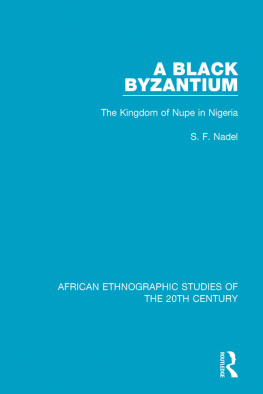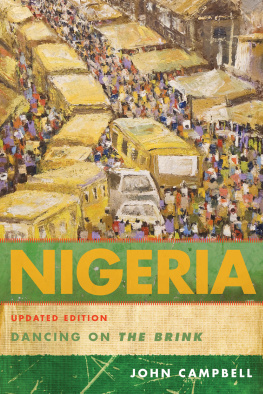AFRICAN ETHNOGRAPHIC STUDIES
OF THE 20TH CENTURY
Volume 49
A BLACK BYZANTIUM
A BLACK BYZANTIUM
The Kingdom of Nupe in Nigeria
S. F. NADEL
First published in 1942 by Oxford University Press for the International African Institute.
This edition first published in 2018
by Routledge
2 Park Square, Milton Park, Abingdon, Oxon OX14 4RN
and by Routledge
711 Third Avenue, New York, NY 10017
Routledge is an imprint of the Taylor & Francis Group, an informa business
1942 International African Institute
All rights reserved. No part of this book may be reprinted or reproduced or utilised in any form or by any electronic, mechanical, or other means, now known or hereafter invented, including photocopying and recording, or in any information storage or retrieval system, without permission in writing from the publishers.
Trademark notice: Product or corporate names may be trademarks or registered trademarks, and are used only for identification and explanation without intent to infringe.
British Library Cataloguing in Publication Data
A catalogue record for this book is available from the British Library
ISBN: 978-0-8153-8713-8 (Set)
ISBN: 978-0-429-48813-9 (Set) (ebk)
ISBN: 978-1-138-59665-8 (Volume 49) (hbk)
ISBN: 978-0-429-48754-5 (Volume 49) (ebk)
Publishers Note
The publisher has gone to great lengths to ensure the quality of this reprint but points out that some imperfections in the original copies may be apparent.
Disclaimer
The publisher has made every effort to trace copyright holders and would welcome correspondence from those they have been unable to trace.
THE ETSU NUPE
A
BLACK BYZANTIUM
THE KINGDOM OF NUPE IN NIGERIA
BY
S. F. NADEL, P H .D.
WITH A FOREWORD BY
T HE R IGHT H ON . LORD LUGARD
G . C . M . G ., D . S . O ., O . B . E .
Published for the
INTERNATIONAL AFRICAN INSTITUTE
by the
OXFORD UNIVERSITY PRESS
LONDON NEW YORK TORONTO
TO
MY WIFE
WHOSE BOOK THIS IS
AS MUCH AS MINE
CONTENTS
Oxford University Press, Ely House, London W. 1
GLASGOW NEW YORK TORONTO MELBOURNE WELLINGTON
CAPE TOWN IBADAN NAIROBI DAR ES SALAAM LUSAKA ADDIS ABABA
DELHI BOMBAY CALCUTTA MADRAS KARACHI LAHORE DACCA
KUALA LUMPUR SINGAPORE HONG KONG TOKYO
ISBN 0 19 724123 9
First edition 1942
Reprinted 1946, 1951, 1961, 1965, 1969, and 1973
All rights reserved. No part of this publication may be reproduced, stored in a retrieval system, or transmitted, in any form or by any means, electronic, mechanical, photocopying, recording, or otherwise, without the prior permission of Oxford University Press
Printed in Great Britain at the University Press, Oxford by Vivian Ridler Printer to the University
LIST OF ILLUSTRATIONS
MAPS
By L ORD L UGARD
T HIS exhaustive treatise on one of the most important communities in Nigeria owes its inception to the generosity of the Rockefeller Foundation of New York, which placed a large sum at the disposal of the International Institute for the Study of African Languages and Cultures. Fellowships were instituted to enable specially trained students to undertake scientific research into the social organization of a selected unit of African society, the factors of social cohesion which operate to prevent its disintegration by contact with European civilization, the openings for co-operation, and the tendencies towards new groupings. Others were specially concerned with linguistic studies.
Dr. Nadel, of the University of Vienna, was one of the original Fellows, and he selected the Nupe of the middle Niger for his field of research. He brought to his task not only a thorough mastery of the technique of scientific investigation, but an original mind, and a sympathy with and understanding of the African, which won the confidence and friendship without which scientific qualifications can effect little.
His exceptional talents as a linguist enabled him not only to converse, at first in the lingua franca (Hausa), but in less than six months to acquire, and speak with fluency the very difficult tone language of the Nupe. Many an English reader of this book may even envy his command of idiomatic English. The Nupe seem to have regarded him as an unusual phenomenon and conferred upon him a high title of tribal rank.
As an Anthropologist he is concerned at the outset to explain that the termwhether functional, practical, or appliedis ill adapted to the research he had undertaken. But surely the study of a native society in all its complexity, and the factors which had affected its social evolution are better described as Sociology than as Anthropologywhich is defined as the study of man as an animal? A clear understanding on the other hand of the connotation of the term Culture as used by a highly qualified sociologist is essential to the appreciation of his work.
Culture (he says) varies with environment and expresses the changing dominant interests involved in social, political, and economic conditions. It is not a sum total of discrete traits (but) a conscious unity created by and embodied in a common group life (by) the people who form the group, specific to it and only to it irrespective of variations within, or similarities with groups outside, the tribal boundaries. (pp. 1415.)
The distinctive individuality of the tribe depends in turn on the presumption that it is a group possessing more or less the same culture and language.
The social and economic complexity of the Nupe State as it exists to-day is epitomized in the comparison he has chosen as the title for his book. Affiliations with neighbouring tribes, migrations to found new settlements, and above all the influence of foreign rulers have introduced modifications, but without radical change in the traditional culture. The complete absence of any written records, and the reticence of the people until complete confidence had been established, accentuate the difficulty of elucidating the origin of the tribe before and up to the death of Tsoede, the mythical founder of the kingdom. From the end of the sixteenth century, however, the history can claim comparative accuracy. Comparison of the Nupe language with those of neighbouring tribes is complicated by the existence of five distinct dialects.
Dr. Nadels first object was to discriminate between the essential characteristics of Nupe culture, and the variations from the typical pattern in a heterogeneous society divided by gulfs of culture, ethnic extraction, community, and class. For this purpose he considered that what he calls the anthropological quadriviumkinship, political organization, economics and religionwas unsuitable, and decided to base his research on the two inseparable aspects of culture, political and economic organization, with special reference to religion and law.
This involved in the first place an examination of the factors of social cohesion upon which the claim of a community to rank as a unit of self-government is based, and in the second place the effect of changes brought about,











